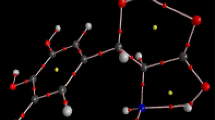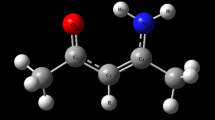Abstract
Context
Dopamine (DA) is one of the most important neurotransmitters associated with numerous neural disorders. This investigation reports the intramolecular interactions present in the isomers of neutral (DA0), anionic (DA−), and cationic (DA+) dopamine isomers in gas, water, and ethanol mediums. Neutral and anion isomers have O-H∙∙∙O, C-H∙∙∙N intramolecular hydrogen bonds and N-H∙∙∙π interactions. All the interactions are electrostatic in nature. Isomers of cation dopamine show no intramolecular interactions in the solvent. Natural charges from natural bond orbital (NBO) analysis show that O-H∙∙∙O bonds and the N-H∙∙∙π interactions are the most and least polar, respectively. 1H NMR study reveals the inverse linear correlation between shielding constant and electron density in a solvent medium. HOMO-LUMO energy gap indicates higher stability for neutral and cationic forms of dopamine isomers in water and ethanol medium.
Methods
We have optimized all the structural forms of dopamine molecule using the Becke three hybrid exchange and Lee-Yang-Parr correlation functional with Grimme’s dispersion correction, B3LYP-D3(BJ), and aug-cc-pVTZ basis set using the Gaussian16 software. Vibrational frequency analysis with no imaginary frequencies confirms the nature of global minima. The solvent studies (water and ethanol) were carried out using the SCRF keyword and the polarisable continuum model (PCM) of Miertus and Tomasi. NBO analysis and NMR studies were also performed for all conformers. Topology analysis was explored using the software Multiwfn.





Similar content being viewed by others
References
Niyonambaza SD et al (2019) A review of neurotransmitters sensing methods for neuro-engineering research. Appl Sci 9(21)
Chauhan N et al (2020) Recent advancement in nanosensors for neurotransmitters detection: present and future perspective. Process Biochem 91:241–259
Banerjee S et al (2020) Electrochemical detection of neurotransmitters. Biosensors 10(8):101
Ortiz-Medina J et al (2015) Differential response of doped/defective graphene and dopamine to electric fields: a density functional theory study. J Phys Chem C 119(24):13972–13978
Shen Y et al (2019) Treatment of magnesium-L-threonate elevates the magnesium level in the cerebrospinal fluid and attenuates motor deficits and dopamine neuron loss in a mouse model of Parkinson’s disease. Neuropsychiatr Dis Treat 15:3143–3153
Pande S et al (2009) Dopamine molecules on Aucore−Agshell bimetallic nanocolloids: Fourier transform infrared, Raman, and surface-enhanced Raman spectroscopy study aided by density functional theory. J Phys Chem C 113(17):6989–7002
Musacchio JM (1975) Enzymes involved in the biosynthesis and degradation of catecholamines. In: Iversen LL, Iversen SD, Snyder SH (eds) Biochemistry of biogenic amines. Springer US, Boston, MA, pp 1–35
Cruickshank L, Kennedy AR, Shankland N (2013) Tautomeric and ionisation forms of dopamine and tyramine in the solid state. J Mol Struct 1051:132–136
Ireta J, Neugebauer J, Scheffler M (2004) On the accuracy of DFT for describing hydrogen bonds: dependence on the bond directionality. J Phys Chem A 108(2004):5692–5698
Fernández JA (2020) Exploring hydrogen bond in biological molecules. Journal of the Indian Institute of Science 100(1):135–154
Wojtulewski S, Grabowski SJ (2003) DFT and AIM studies on two-ring resonance assisted hydrogen bonds. J Mol Struct THEOCHEM 621(3):285–291
Efimov AV, Brazhnikov EV (2003) Relationship between intramolecular hydrogen bonding and solvent accessibility of side-chain donors and acceptors in proteins. FEBS Lett 554(3):389–393
Mallajosyula SS, MacKerell Jr AD (2011) Influence of solvent and intramolecular hydrogen bonding on the conformational properties of O-linked glycopeptides. J Phys Chem B 115(38):11215–11229
Trendafilova N, Bauer G, Mihaylov T (2004) DFT and AIM studies of intramolecular hydrogen bonds in dicoumarols. Chem Phys 302(1):95–104
Deshmukh MM, Bartolotti LJ, Gadre SR (2011) Intramolecular hydrogen bond energy and cooperative interactions in α-, β-, and γ-cyclodextrin conformers. J Comput Chem 32(14):2996–3004
Vatrál J, Boca R, Linert W (2015) Oxidation properties of dopamine at and near physiological conditions. Monatshefte für Chemie - Chemical Monthly 146
Jha O, Yadav TK, Yadav RA (2018) Structural and vibrational study of a neurotransmitter molecule: dopamine [4-(2-aminoethyl) benzene-1,2-diol]. Spectrochim Acta A Mol Biomol Spectrosc 189:473–484
Ren H-C et al (2018) Two-dimensional infrared spectra of cationic dopamine under different electric fields: theoretical studies from the density function theory anharmonic potential. J Phys Chem C 122(31):17994–18004
Ciubuc JD et al (2017) Raman computational and experimental studies of dopamine detection. Biosensors 7(4):43
Gong C et al (2019) Stable parent anions of dopamine and adrenaline: a new form of neurotransmitters. J Phys Chem B 123(36):7695–7699
Wang HY, Sun Y, Tang B (2002) Study on fluorescence property of dopamine and determination of dopamine by fluorimetry. Talanta 57(5):899–907
Cabezas C et al (2013) Seven conformers of neutral dopamine revealed in the gas phase. The Journal of Physical Chemistry Letters 4(3):486–490
Nagy PI, Alagona G, Ghio C (1999) Theoretical studies on the conformation of protonated dopamine in the gas phase and in aqueous solution. J Am Chem Soc 121(20):4804–4815
Lagutschenkov A et al (2011) Infrared spectra of protonated neurotransmitters: dopamine. Phys Chem Chem Phys 13(7):2815–2823
Urban JJ, Cramer CJ, Famini GR (1992) A computational study of solvent effects on the conformation of dopamine. J Am Chem Soc 114(21):8226–8231
Giesecke J (1980) Refinement of the structure of dopamine hydrochloride. Acta Crystallographica Section B Structural Crystallography and Crystal Chemistry 36:178–181
García-Hernández E, Garza J (2017) Reactivity sites in dopamine depend on its intramolecular hydrogen bond. Revista de la Sociedad Química de Mexico 61:222–228
Araújo RL et al (2020) Insights into solid-state properties of dopamine and L-Dopa hydrochloride crystals through DFT calculations. Chem Phys Lett 761:138033
Becke AD (1988) Density-functional exchange-energy approximation with correct asymptotic behavior. Phys Rev A 38(6):3098–3100
Becke AD (1993) Density-functional thermochemistry. III. The role of exact exchange. J Chem Phys 98(7):5648–5652
Reichardt C (1982) Solvent effects on chemical reactivity. Pure Appl Chem 54(10):1867–1884
Mohammad-Shiri H et al (2011) Computational and electrochemical studies on the redox reaction of dopamine in aqueous solution. Int J Electrochem Sci 6:317–336
Lamborelle C, Tapia O (1979) A quantum chemical study of solvent effects on biomolecules: an application of the virtual charge model and the self-consistent reaction field theory of solvent effect to γ-amino butyric acid, β-alanine and glycine. Chem Phys 42(1):25–40
Miertuš S, Scrocco E, Tomasi J (1981) Electrostatic interaction of a solute with a continuum. A direct utilizaion of AB initio molecular potentials for the prevision of solvent effects. Chem Phys 55(1):117–129
Izato Y-I et al (2019) A simple heuristic approach to estimate the thermochemistry of condensed-phase molecules based on the polarizable continuum model. Phys Chem Chem Phys 21(35):18920–18929
Casey G et al (2011) Quantum chemical calculations on solvation effects for selected photoreactive aromatic organic molecules of atmospheric relevance. Computational and Theoretical Chemistry 965(2):346–352
Weinhold F (2012) Natural bond orbital analysis: a critical overview of relationships to alternative bonding perspectives. J Comput Chem 33(30):2363–2379
Lodewyk MW, Siebert MR, Tantillo DJ (2012) Computational prediction of 1H and 13C chemical shifts: a useful tool for natural product, mechanistic, and synthetic organic chemistry. Chem Rev 112(3):1839–1862
Li J, Liu JK, Wang WX (2020) GIAO (13) C NMR calculation with sorted training sets improves accuracy and reliability for structural assignation. J Organomet Chem 85(17):11350–11358
Lee C, Yang W, Parr RG (1988) Development of the Colle-Salvetti correlation-energy formula into a functional of the electron density. Phys Rev B 37(2):785–789
Lu T, Chen F (2012) Multiwfn: a multifunctional wavefunction analyzer. J Comput Chem 33(5):580–592
Libowitzky E (1999) Correlation of O-H stretching frequencies and O-H … O hydrogen bond lengths in minerals. Monatshefte für Chemie / Chemical Monthly 130(8):1047–1059
Thiruppathiraja T et al (2020) H, OH and COOH functionalized magnesium phthalocyanine as a catalyst for oxygen reduction reaction (ORR) — a DFT study. Int J Hydrog Energy 45:8540–8548
Shyama M et al (2021) Complexes of criegee intermediate CH2OO with CO, CO2, H2O, SO2, NO2, CH3OH, HCOOH and CH3CH3CO molecules — a DFT study on bonding, energetics and spectra. Computational and Theoretical Chemistry 1203:113341
Umadevi P, Senthilkumar L (2014) Influence of metal ions (Zn2+, Cu2+, Ca2+, Mg2+ and Na+) on the water coordinated neutral and zwitterionic l-histidine dimer. RSC Adv 4(90):49040–49052
Kumar PSV, Raghavendra V, Subramanian V (2016) Bader’s theory of atoms in molecules (AIM) and its applications to chemical bonding. J Chem Sci 128(10):1527–1536
Priya M, Senthilkumar L, Kolandaivel P (2014) Hydrogen-bonded complexes of serotonin with methanol and ethanol: A DFT study. Struct Chem 25
Yannacone SF, Sethio D, Kraka E (2020) Quantitative assessment of intramolecular hydrogen bonds in neutral histidine. Theor Chem Accounts 139(7):125
Palanivel U, Lakshmipathi S (2016) Hydrogen bonds in Zif268 proteins — a theoretical perspective. J Biomol Struct Dyn 34(8):1607–1624
Shyama M, Lakshmipathi S (2019) C–H···O interaction between cation and anion in amino acid-based ionic liquids—A DFT study in gas and solvent phase. Struct Chem 30:185–194
Venkatachalam U, Senthilkumar L, Kolandaivel P (2013) Theoretical investigations on the hydrogen bonding of nitrile isomers with H2O, HF, NH3 and H2S. Mol Simul 39:908
Senthilkumar L et al (2006) Hydrogen bonding in substituted formic acid dimers. J Phys Chem A 110(46):12623–12628
Yates JR et al (2005) A combined first principles computational and solid-state NMR study of a molecular crystal: flurbiprofen. Phys Chem Chem Phys 7(7):1402–1407
Mitchell, P., A chemist’s guide to density functional theory. Wolfram Koch and Max C. Holthausen. Wiley-VCH, Weinheim, 2000. x?+?294 pages. 70 ISBN 3-527-29918-1. Applied Organometallic Chemistry - APPL ORGANOMETAL CHEM, 2000. 14: p. 745-746.
Author information
Authors and Affiliations
Contributions
T. Sangeetha: conceptualization, methodology, formal analysis, writing — review and editing; Senthilkumar Lakshmipathi: conceptualisation, methodology, formal analysis, writing — review and editing.
Corresponding author
Ethics declarations
Ethical statement
All the ethical guidelines have adhered to.
Consent to participate
All authors have participated in this work.
Consent for publication
All authors have agreed to publish this work.
Conflict of interest
The authors declare no competing interests.
Additional information
Publisher’s note
Springer Nature remains neutral with regard to jurisdictional claims in published maps and institutional affiliations.
Supplementary information
ESM 1:
All optimized geometries in gas and solvents, geometrical parameters of neutral, cation, and anion dopamine molecules, calculated electronic energy and energy gap, dipole moment, Natural charge of proton acceptor (q1) and proton donor (q2) NMR studies, optimized geometry coordinates (cartesian) of all dopamine molecular conformers are given in supplementary information. (DOCX 5433 kb)
Rights and permissions
Springer Nature or its licensor (e.g. a society or other partner) holds exclusive rights to this article under a publishing agreement with the author(s) or other rightsholder(s); author self-archiving of the accepted manuscript version of this article is solely governed by the terms of such publishing agreement and applicable law.
About this article
Cite this article
Sangeetha, T., Lakshmipathi, S. Intramolecular interactions (O-H∙∙∙O, C-H∙∙∙N, N-H∙∙∙π) in isomers of neutral, cation, and anion dopamine molecules: A DFT study on the influence of solvents (water and ethanol). J Mol Model 29, 67 (2023). https://doi.org/10.1007/s00894-023-05466-y
Received:
Accepted:
Published:
DOI: https://doi.org/10.1007/s00894-023-05466-y




